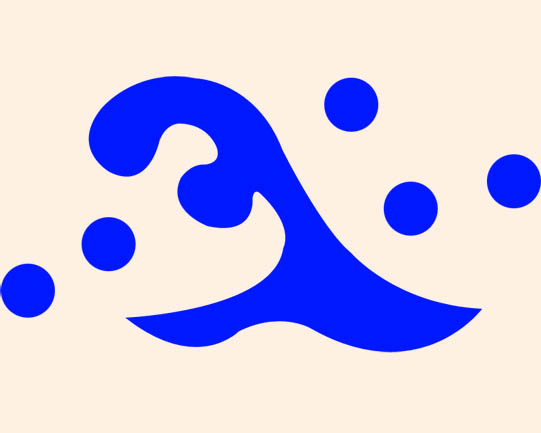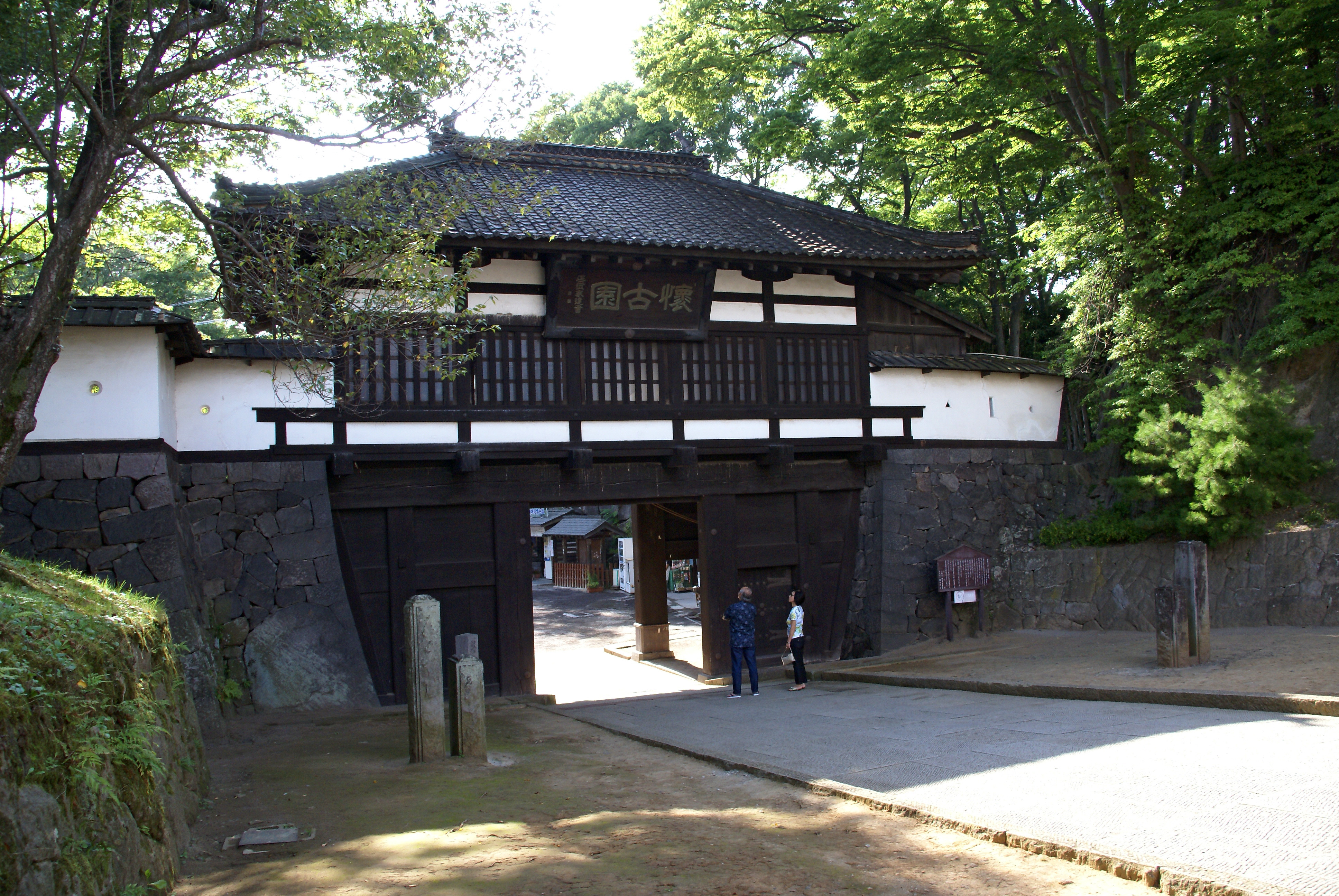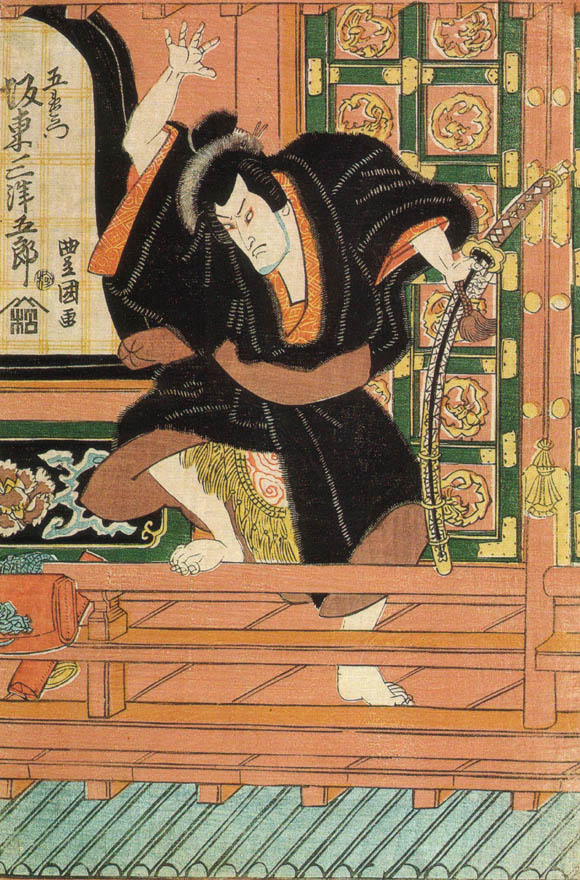|
Sengoku Hidehisa
, childhood name Gonbei (権兵衛) was a samurai warrior of the Sengoku period and the Edo period. He was the head of the Komoro Domain in Shinano Province. Papinot, Jacques Edmond Joseph. (1906). ''Dictionnaire d'histoire et de géographie du Japon''; Papinot, (2003)"Sengoku" at ''Nobiliare du Japon'', p. 54 retrieved 2013-4-11. Hidehisa is also credited with being the man who captured the legendary outlaw hero "Ishikawa Goemon". Early life According to his family records, Hidehisa was the fourth son of his family, a low ranking samurai family in the Saitō clan. He was adopted out to another family at a young age, but eventually his older brothers died of illness and he was recalled to inherit his family name. During Mino Campaign, his clan was destroyed by Oda Nobunaga and he was captured during the assault. He then became a member of the Oda clan and was ordered to serve under Kinoshita Tōkichirō (the eventual Toyotomi Hideyoshi). Hidehisa took part in most of the Oda cl ... [...More Info...] [...Related Items...] OR: [Wikipedia] [Google] [Baidu] |
Komoro Domain
was a feudal domain under the Tokugawa shogunate of Edo period Japan. It is located in Shinano Province, Honshū. The domain was centered at Komoro Castle, located in what is now part of the city of Komoro in Nagano Prefecture."Shinano Province" at JapaneseCastleExplorer.com retrieved 2013-5-13. History The area which later became Komoro Domain was repeated contested between the , the and the |
Battle Of Hetsugigawa
The was the last battle before the Toyotomi main army's arrival on Kyūshū during Japan's Sengoku period. In 1586 at Hetsugigawa (present Ōnogawa) in Bungo province Toyotomi's vanguard divisions under Chōsokabe Motochika and Sengoku Hidehisa landed on Kyūshū with orders to act defensively until further troops were able to join them. But the advance party decided to disobey Hideyoshi's commands and relieve the castle of Toshimitsu. The Shimazu besieging army noted their approach, and redoubled their efforts to take Toshimitsu castle, so that when the invaders arrived at the Hetsugi river, which flowed within sight of the castle, they could see the flags of Shimazu flying from its towers. Motochika proposed a withdrawal, but his companions, Yoshimune and Hidehisa, insisted on doing battle, so the Shimazu set their trap. The decoy force led by Ijuin Hisanori attacked across the river and then withdrew, which persuaded the allied left wing to follow them. They were met by arq ... [...More Info...] [...Related Items...] OR: [Wikipedia] [Google] [Baidu] |
Invasion Of Shikoku
The was a conflict of the Sengoku period of Japan fought between Toyotomi Hideyoshi and Chōsokabe Motochika on the island of Shikoku in 1585. Hideyoshi invaded Shikoku with a force of over 100,000 men in June and led a campaign against the Chōsokabe clan force of 40,000 men for control over the island. Hideyoshi's army was successful and conquered most of Shikoku within two months, and defeated Chōsokabe when he surrendered Ichinomiya Castle in August. Background In the 1570s, Chōsokabe Motochika launched a campaign to personally unify Shikoku, the smallest of Japan's four main islands, and defeated a number of ''samurai'' rivals over the next decade. In 1580, Chōsokabe came into conflict with Oda Nobunaga after rejecting a request to submit to him. By 1583, Chōsokabe was the most powerful warlord on Shikoku and had conquered most of the island's four provinces of Iyo, Sanuki, Awa, and Tosa. That year, Chōsokabe had defeated Sengoku Hidehisa, a retainer of Nobunaga ... [...More Info...] [...Related Items...] OR: [Wikipedia] [Google] [Baidu] |
Sumoto Castle
was a Muromachi to Sengoku period Japanese castle located in the Orodani neighborhood of the city of Sumoto, Hyōgo Prefecture, Japan. Its ruins have been protected as a National Historic Site since 1999. It was also referred to as . Overview Sumoto Castle located on the southeast coast of Awaji Island on a long and narrow ridge of the 130-meter Mount Mikuma. Awaji Island has been a strategic transportation hub for the Kinai region since ancient times, forming part of the route between Honshu and Shikoku and controlling maritime transportation between the Pacific Ocean and the Seto Inland Sea and Osaka Bay. In the Sengoku period, the island was controlled by the Miyoshi clan, who ruled Sanuki, Awa and Kawachi Provinces. Sumoto Castle was constructed by their retainer, the Otaki clan, around 1526. The island was seized by Hashiba Hideyoshi in 1581 as part of Oda Nobunaga's conquest of western Japan, and assigned his general Sengoku Hidehisa to govern Sumoto. In 1583, Sengo ... [...More Info...] [...Related Items...] OR: [Wikipedia] [Google] [Baidu] |
Daimyō
were powerful Japanese magnates, feudal lords who, from the 10th century to the early Meiji era, Meiji period in the middle 19th century, ruled most of Japan from their vast, hereditary land holdings. They were subordinate to the shogun and nominally to the Emperor of Japan, emperor and the ''kuge''. In the term, means 'large', and stands for , meaning 'private land'. From the ''shugo'' of the Muromachi period through the Sengoku period, Sengoku to the ''daimyo'' of the Edo period, the rank had a long and varied history. The backgrounds of ''daimyo'' also varied considerably; while some ''daimyo'' clans, notably the Mōri clan, Mōri, Shimazu clan, Shimazu and Hosokawa clan, Hosokawa, were cadet branches of the Imperial family or were descended from the ''kuge'', other ''daimyo'' were promoted from the ranks of the samurai, notably during the Edo period. ''Daimyo'' often hired samurai to guard their land, and they paid the samurai in land or food as relatively few could aff ... [...More Info...] [...Related Items...] OR: [Wikipedia] [Google] [Baidu] |
Toyotomi Hideyoshi
, otherwise known as and , was a Japanese samurai and ''daimyō'' (feudal lord) of the late Sengoku period regarded as the second "Great Unifier" of Japan.Richard Holmes, The World Atlas of Warfare: Military Innovations that Changed the Course of History, Viking Press 1988. p. 68. Hideyoshi rose from a peasant background as a Affinity (medieval), retainer of the prominent lord Oda Nobunaga to become one of the most powerful men in Japan. Hideyoshi succeeded Nobunaga after the Honnō-ji Incident in 1582 and continued Nobunaga's campaign to unite Japan that led to the closing of the Sengoku period. Hideyoshi became the ''de facto'' leader of Japan and acquired the prestigious positions of Daijō-daijin, Chancellor of the Realm and Sesshō and Kampaku, Imperial Regent by the mid-1580s. Hideyoshi launched the Japanese invasions of Korea (1592–1598), Japanese invasions of Korea in 1592 to initial success, but eventual military stalemate damaged his prestige before his death in 1 ... [...More Info...] [...Related Items...] OR: [Wikipedia] [Google] [Baidu] |
Oda Nobunaga
was a Japanese ''daimyō'' and one of the leading figures of the Sengoku period. He is regarded as the first "Great Unifier" of Japan. Nobunaga was head of the very powerful Oda clan, and launched a war against other ''daimyō'' to unify Japan in the 1560s. Nobunaga emerged as the most powerful ''daimyō'', overthrowing the nominally ruling shogun Ashikaga Yoshiaki and dissolving the Ashikaga Shogunate in 1573. He conquered most of Honshu island by 1580, and defeated the ''Ikkō-ikki'' rebels in the 1580s. Nobunaga's rule was noted for innovative military tactics, fostering of free trade, reforms of Japan's civil government, and the start of the Momoyama historical art period, but also for the brutal suppression of those who refused to cooperate or yield to his demands. Nobunaga was killed in the Honnō-ji Incident in 1582, when his retainer Akechi Mitsuhide ambushed him in Kyoto and forced him to commit . Nobunaga was succeeded by Toyotomi Hideyoshi, who along with Toku ... [...More Info...] [...Related Items...] OR: [Wikipedia] [Google] [Baidu] |
Ishikawa Goemon
was a legendary Japanese outlaw hero who stole gold and other valuables to give to the poor. He and his son were boiled alive in public after their failed assassination attempt on the Sengoku period warlord Toyotomi Hideyoshi. His legend lives on in contemporary Japanese popular culture, often giving him greatly exaggerated ninja skills. Biography There is little historical information on Goemon's life, and as he has become a folk hero, his background and origins have been widely speculated upon. In his first appearance in the historical annals, in the 1642 biography of Hideyoshi, Goemon was referred to simply as a thief. As his legend became popular, various anti-authoritarian exploits were attributed to him, including a supposed assassination attempt against the Oda clan warlord Oda Nobunaga. There are many versions of Goemon's background and accounts of his life. According to one of them, he was born as Sanada Kuranoshin in 1558 to a samurai family in service of the power ... [...More Info...] [...Related Items...] OR: [Wikipedia] [Google] [Baidu] |
Edmond Papinot
Jacques Edmond-Joseph Papinot (1860–1942) was a French Roman Catholic priest and missionary who was also known in Japan as . He was an architect, academic, historian, editor, Japanologist. Papinot is best known for creating an ''Historical and Geographical Dictionary of Japan'' which was first published in French in 1899. The work was published in English in 1906. Early life Papinot was born in 1860 in Châlons-sur-Saône in France.Pouillon, François. (2008)''Dictionnaire des orientalistes de langue française,'' p. 736 He was ordained as a Catholic priest in 1886; and three months later he was sent to Japan. Career Papinot first arrived in Japan in 1886. He taught at the Tokyo Theological Seminary for 15 years while working on his ''Dictionnaire japonais-français des noms principaux de l'histoire et de la géographie de Japon''.Rogala, Jozef. (2012)''A Collector's Guide to Books on Japan in English,'' p. 187 In 1911, he left Japan for China. He returned to France in 1920 ... [...More Info...] [...Related Items...] OR: [Wikipedia] [Google] [Baidu] |
Edo Period
The or is the period between 1603 and 1867 in the history of Japan, when Japan was under the rule of the Tokugawa shogunate and the country's 300 regional '' daimyo''. Emerging from the chaos of the Sengoku period, the Edo period was characterized by economic growth, strict social order, isolationist foreign policies, a stable population, perpetual peace, and popular enjoyment of arts and culture. The period derives its name from Edo (now Tokyo), where on March 24, 1603, the shogunate was officially established by Tokugawa Ieyasu. The period came to an end with the Meiji Restoration and the Boshin War, which restored imperial rule to Japan. Consolidation of the shogunate The Edo period or Tokugawa period is the period between 1603 and 1867 in the history of Japan, when Japan was under the rule of the Tokugawa shogunate and the country's regional '' daimyo''. A revolution took place from the time of the Kamakura shogunate, which existed with the Tennō's court, to the Tok ... [...More Info...] [...Related Items...] OR: [Wikipedia] [Google] [Baidu] |





